A chronology of events in 1941.
January 1941
Mediterranean
07 January – Italian torpedo boat Clio sinks Free French submarine Narval off the coast of Tobruk, Libya.
Free French submarine Narval was also reported sunk 35°03 North and 11°53 East off Tunisia, between 13 and 16 December 1940. The wreck lies not far from the Italian torpedo boat La Farina.~ Additional commentary courtesy Jean-Louis Maurette (jean-louis.maurett(@)libertysurf.fr)
Sudan
January – The Duke of Aosta orders the abandonment of Gallabat and Kassala and moves his 50,000 man army to the more rugged ground in Agordat and Barentu east of Kassala.
Mediterranean
10 January – British destroyer HMS Hereward sinks Italian torpedo boat Vega off Pantelleria.
Eritrea
12 January – The Duke of Aosta sends Elite Savoia Grenadiers to defend Keren.
Ethiopia/Sudan Border
20 January – Emperor Haile Selassie returns to Ethiopia under the protection of the British.
Libya
22 January – British and Australian forces take Tobruk from the Italians. Italian coastal defense ship San Giorgio is scuttled off Tobruk by the Italian crew. San Giorgio is cited for the crew’s bravery in maintaining its position and bombing advancing Commonwealth forces, halting them for 11 hours.

The San Giorgio in January 1941. Image: Archivio Centrale dello Stato
24 January – The first real “armored clash” is spawned at El Mechili *. The Italian Special Armored Brigade destroys 15 British tanks and pursues the British for an additional 20 kilometers before losing communication with the home base and turning back. They then destroy another 6 tanks from a British counterattack. O’Connor orders a two-week halt to bring in fresh supplies after his 70 cruisers are reduced to 50, and 120 light tanks reduced to 95. He considers this force to small to attack the 57 M13/40’s and 25 L3/35 Tankettes of the Italian Brigade.
* Playfair vol.1 p.353: States the British 4th Armoured Brigade at Mechili lost one cruiser tank and six light tanks. After the action, the British counted 8 Italian medium tanks destroyed and one captured. The action had no effect on O’Connor’s operations – indeed, the British perception was that they had an opportunity to destroy the Italian armor, and wished to increase their pursuit. However, O’Connor’s advance was stopped four days later by heavy rain and running out of petrol. The Regimental History of 3rd Hussars states that the light tanks were knocked out by the Italians only after they had broken down first. These figures are confirmed in the War Diaries of 3rd Hussars and 2nd Royal Tank Regiment.~ Additional commentary courtesy Paul (goldwood(@)paradise.net.nz)
* Mario Paesani, who consulted various Italian military publications, reports in his website Italians Tanks at War, that there were two clashes in the armored battle and that the Italian tankers claim to have damaged or destroyed 25 British tanks. According to reports in United Press and Associated Press dispatches from Cairo, four Italian tanks were destroyed and two captured in the battle. Additional commentary by David Aldea (2manypeople(@)gmail.com)
Eritrea
27 January – Two Indian Divisions under Major General Platt attack Agordat and 2 Indian Infantry Brigades attack Barentu.
31 January – After three days of heavy fighting, the Italian Army withdraws to the Keren Plateau. At this point, the Duke of Aosta, in command at Addis Ababa, has only 67 aircraft available for combat in all East Africa. Fuel and supplies are at an all-time low, and infantry could only be moved on foot. But in North Africa, the Italians bring in more and better tanks and no longer use them in a haphazard way as the Maletti Group and Brigata Corazzata Speciale (Special Brigade Unit). They are now grouped in organic armored and motorized divisions and the M13/40’s prove very effective when used “en masse”. Italy now has in North Africa their first company of motorized cars with RECAM (Reparto Esplorante di Corpo d’Armata di Manovra – Reconnaissance Unit of the Army Mobile Corps).
February 1941
Eritrea
03 February – The British attack Keren with a force of 30,000 against 23,000 Italians made up of 3 Brigades of Colonial Levies and 3 Brigades of Savoia Grenadiers. After attacks and counterattacks, the Italians were able to push the Indian Infantry Brigade back. The Scotts attack and are also repelled by the Italians. Finally, on March 27, the British were able to push the Italian forces back from Keren after seven weeks of fighting. In this battle, 3,000 Italians die and 500 British die with 3,000 wounded.
See Battle of Keren.
Libya
05 February – British strike in Libya south of Gebel el Akhdar, encircling what is left of the Italian 10th Army.
Italy
09 February – British naval forces bombard Genoa and Livorno.
Libya
12 February – By mid-February, the British have taken a total of 115,000 Italian POW’s, 845 guns and the destruction of 380 light and medium Italian tanks. The British had also managed to destroy 200 of the 564 Italian aircraft. The British, on the other hand, have lost 80% of their vehicles and all their “I’ tanks as well as most of their light and cruiser tanks. British losses amounted to 2,000 troops, 1 in 25 troops that engaged the Italians were killed.
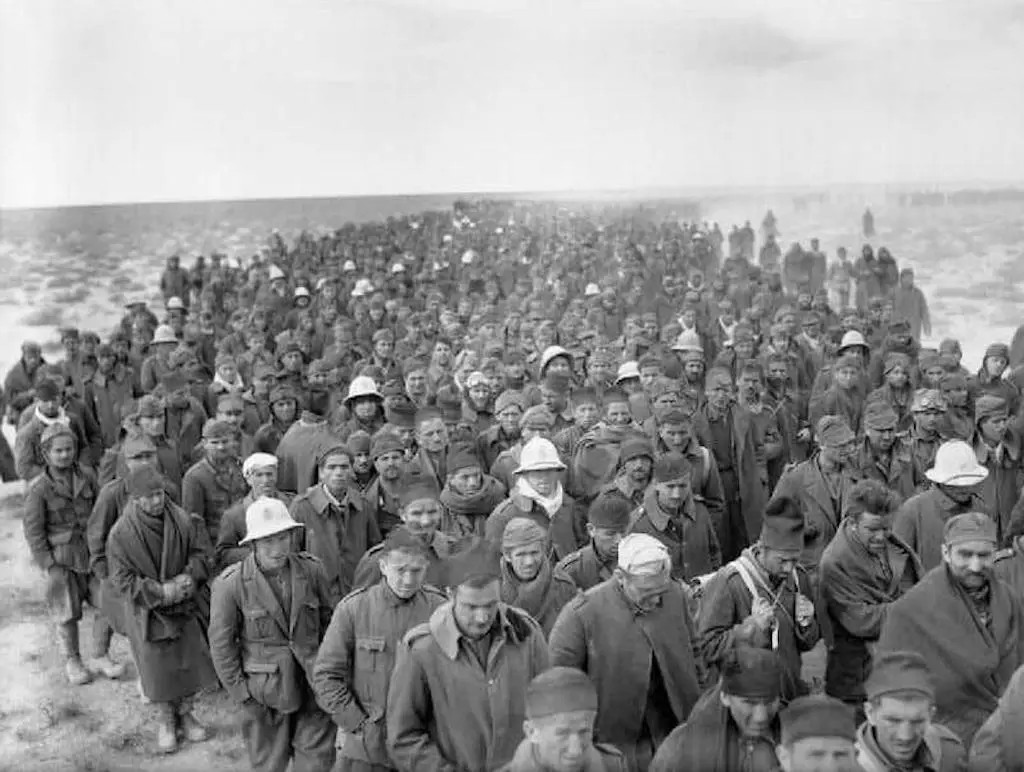
Italian Prisoners of War in Libya, 1941.
Erwin Rommel arrives in Tripoli, Libya with a Panzer and Motorized Infantry Division. He assumes command of the Deutsches Africa Korps. and receives assistance from the Fliegerkorps X and long-range aircraft from Sicily to fight the exhausted British. The German 5th Light Division includes 9,300 Germans, 130 tanks, 111 guns and 2,000 vehicles (80 German aircraft are also included).
The Italian “Ariete” and “Trento” Divisions arrive as well. The “Ariete” is composed of 6,949 men, 163 tanks, 36 field guns, 61 anti-tank guns, and the Brescia Infantry Division. Rommel has 100,000 Italians, 7,000 Italian trucks supplying munitions to the front, 1,000 Italian guns and 151 Italian aircraft.
Ethiopia
19 February – South African troops capture Jumbo after heavy fighting with Italian forces. In 3 hours, Italian Artillery fire over 3,000 shells.
25 February – A motorized Nigerian Brigade reaches the outskirts of Mogadishu, Italian Somaliland. British submarine HMS Upright sinks Italian cruiser Armando Diaz off Tripoli.
Aegean Sea
Operation Abstention: Italy successfully defended the island of Castellorizo during the Battle for Castellorizo fought between 25-28 February 1941.
Libya
End of February – The British are stretched to the limit logistically and Wavell is advised not to attack Tripoli. The Commonwealth supply lines are tethered and the troops are exhausted. Commonwealth equipment is depleted and forced to use Italian armor. The front is now 650 miles long
March 1941
06 March – General Nasi smashes through an Ethiopian battalion near Burye with only 12,000 remaining troops.
Malta
08 March – 152,000 pounds of bombs fall on Malta via Axis planes
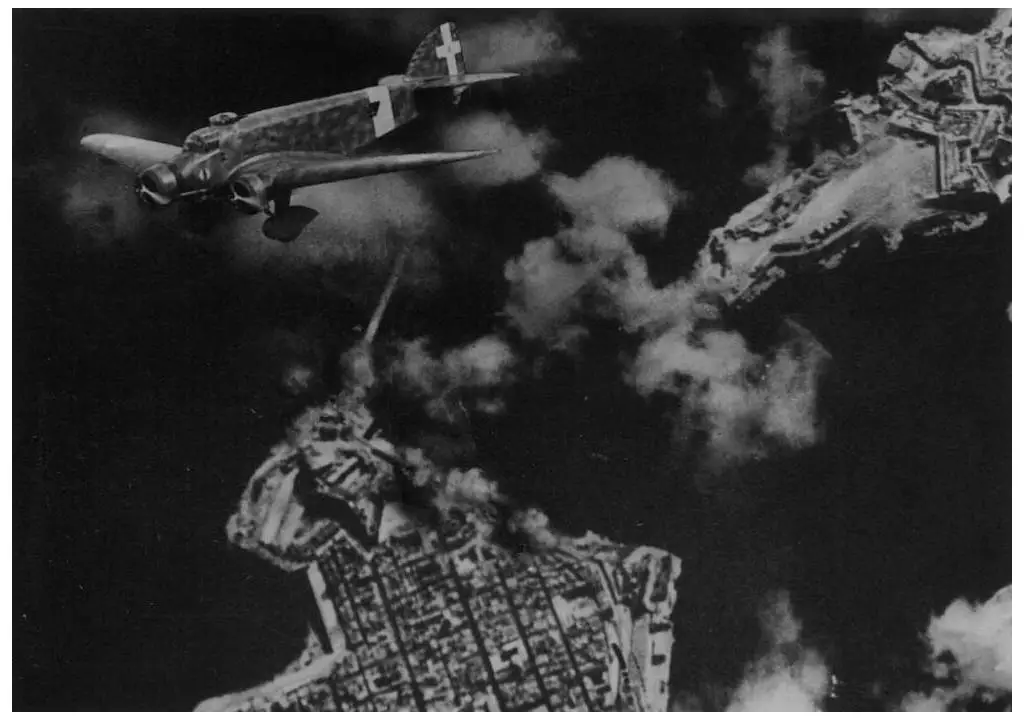
Regia Aeronautica bombing Grand Harbour, Malta in June 1941. Image: Archivio Centrale dello Stato
British Somaliland
16 March – Royal Navy begins pounding installations in Berbera. The city was already abandoned by Italian soldiers. The British regain Berbera later that day.
Albania
17 March – British bombers sink Italian torpedo boat Andromeda off Albania.
Battle of Cape Matapan
27 March – The pressure to disrupt British supply lines in Eastern Mediterranean resulted in Admiral Iachino to set sail towards the east of Crete with the flagship Vittorio Veneto, 4 escort destroyers, the heavy cruisers Trieste, Trento, and Bolzano. East of Sicily, the task force is joined by three Zara Class heavy cruisers, Zara, Pola, and Fiume along with 2 light cruisers from Brindisi. Iachino’s task force is promised full aerial support by both the Regia Aeronautica and the Luftwaffe. Neither Air Force provided these ships with air cover and they were soon spotted by a Sunderland reconnaissance plane flying from Malta. The British dispatched the Warspite, battleships Barham and Valiant, the carrier Formidable and escorting destroyers to the same heading as the Italian force.

A photo of the Bolzano being attacked by Swordfish at the Battle of Cape Matapan. This image was taken from a second Swordfish that just dropped a torpedo at the bottom left of the image.
The battleships never were in the range of each other, but Formidable‘s aircraft began bombing Iachino’s fleet once in range. The Italian battleship Vittorio Veneto is still operational after being hit by torpedos. The cruiser Pola is hit and immobilized by a Swordfish bomber and left behind as the Italian squadron turns about. Admiral Iachino sends back two heavy cruisers with escorting destroyers to pick up survivors. The next day, the heavy cruisers and escorting destroyers, along with the Pola, are sunk by the British who lay waiting. As the British tried saving the survivors on the 29th, the Luftwaffe appears and force them to abandon the rescue operation. An Italian hospital ship is dispatched to the scene to pick up other survivors. This was a devastating loss to the Italian fleet, which never engaged the enemy ships, but forced to fight against British naval aircraft and radar. Italy had neither, and the Battle of Cape Matapan proved the effectiveness of these British assets.
Greece
28 March – Italian ships attack British convoys in Greece. Italian torpedo boat Antonio Chinotto sinks after hitting a mine near Sicily.
29 March – See Battle of Cape Matapan.
31 March – Italian submarine Ambra sinks British cruiser HMS Bonaventure off Crete.
April 1941
April – Italian and German commanders develop Esigenza C3/Operation Herkules for the invasion of Malta. The island is a strategic point for British convoys supplying Commonwealth forces in Africa. The invasion of Malta would take form in the landing of three Italian parachute battalions and one German parachute division with bombing conducted by both Italian and German aircraft. After the capture of Malta, Rommel would drive the Axis forces into Egypt.
Eritrea
01 April – Italian civil authorities in Asmara surrender to the British. In total, the British forces were able to take 40,000 prisoners of war and destroy 6 Italian divisions in three months. Italian destroyer Leone runs aground off Eritrea and is scuttled by its crew to prevent capture by the British.
Libya
March – April – Italian logistics, under Colonels Santamaria and Montemurro, comprised the major work of pursuing the British forces. Rommel moves to the front with his Headquarters on April 3. Italian military leaders in Africa counsel Rommel of the need to beef up the 5th Light, “Ariete”, “Trento”, “Trieste” and 15th Light Panzer Divisions to full strength before conducting any offensive movements. The Oberkommando der Wehrmacht (Armed Forces High Command) also believed that Rommel may try to advance too far.
As feared, Rommel underestimated the need of supplies in this Desert War. Italian logistics had a severe time trying to maintain supplies and Rommel left some units strung out 1,000 kilometers.
03 April – British bombers sink Italian destroyers Daniel Manin and Nazario Sauro off Eritrea. The destroyers Pantera, Tigre, and Cesare Battisti are scuttled near Massaua.
04 April – British bombers sink Italian torpedo boat Giovanni Acerbi near Massaua.
Yugoslavia
06 April – Twenty-eight Italian Divisions and 320 Italian aircraft, in conjunction with German motorized divisions, invade Yugoslavia and Greece. Italians capture some Yugoslav warships.
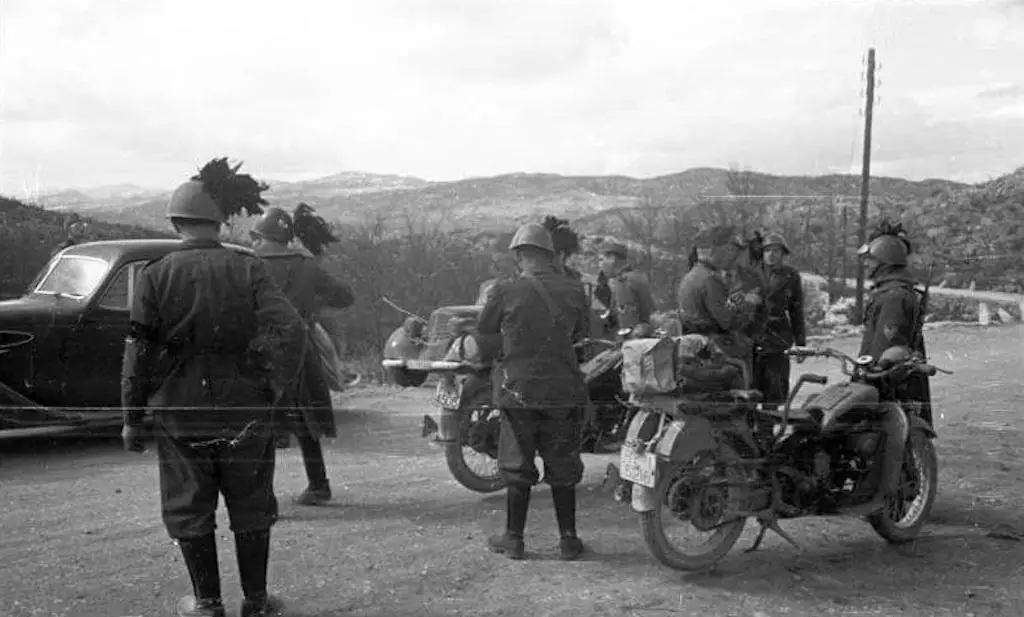
Italian Bersaglieri and German soldiers during the invasion of Yugoslavia in 1941. Image: Bundesarchiv, B 145 Bild-F016230-0009 / CC-BY-SA 3.0
Massaua
08 April – The last Italian warship in East African waters, the torpedo boat Vincenzo Giordano Orsini, is scuttled by its crew prior to the British entering the harbor.
Tunisia Coast
15 April – A convoy of three Italian destroyers and five merchant ships are engaged by the British 14th Flotilla which includes the Mohawk, Nubian, Jervis, and Janus. In this battle, all five merchant ships sink as well as Italian destroyers Luca Tarigo and Baleno.
In an act of bravery, the Italian destroyer Luca Tarigo, attempted to take on the entire British 14th Flotilla alone. A British shell eventually hit the Tarigo’s bridge, blowing the leg off the captain, Commander Pietro de Cristofero. With his leg crudely bandaged, he continued to exchange fire with the British warships until he died of loss of blood. The crew continued to fight on without him and managed to place the Tarigo between the British ships and the convoy. An ensign on the Tarigo launches three torpedoes sinking the HMS Mohawk before Luca Tarigo’s steering gear is destroyed and the deckhouses go up in flames. The Luca Tarigo is hit numerous times and sinks.
Yugoslavia
17 April – Yugoslavia surrenders to Axis forces.
Mediterranean
21 April – British naval forces bomb Tripoli.
Libya
22 April – Rommel finds it increasingly difficult to capture the British. He places the blame on Italian units, especially the Ariete Division. However, it was the German 5th Light Division who became overwhelmed by British Matildas on 22 April and refused to attack. It was the Trento division, according to German accounts, who “erased” the British success against Rommel’s position in late April.
Rommel, glorified by British propaganda as a military genius because of recent British military defeats, begins to deprive Italians of captured goods, fail to include Italians in information exchange for a joint strategy, and destroys the chain of command of Axis African forces by continually seeking Hitler’s intrusion to avoid Italian superiors.
German and Italian commands disobey Rommel’s order to advance to Mersa Matruh, citing it best to protect the flanks by taking Siwa and Jarabub to the south. German Luftwaffe warns Rommel that they would be unable to support a further advance.
24 April – Italian torpedo boat Simone Schiaffino sinks after hitting a mine off Tunisia.
Greece
30 April – The Italian 2nd Battalion paratroopers embark from Lecce on SM-82’s and tasked in seizing Cefalonia. Zante and Itaca are given to the Italian paratroopers to reinforce the garrison of all the Ionian archipelago. Italian paratroopers seize the islands without firing a shot and the operation is a full success. Greece surrenders to Germany and Italy.
Libya
30 April to 04 May – Axis forces attack Tobruk. Reports state that 740 Italians and 658 Germans die. Rommel allows his German units to rest and orders the Italian Brescia, Ariete, and Trento Divisions to contain the British counter-attacks. Axis supply lines now stretch 700 miles.
Rommel further alienates Italian and German units by giving recaptured Italian guns to the Germans at Bardia. He then quickly criticizes Italian supply efforts.
May 1941
Mediterranean
01 May – Italian destroyers sink British submarine HMS Usk off the coast of Sicily.
03 May – British bombers sink Italian torpedo boat Canopo off Tripoli.
04 May – Italian torpedo boat Giuseppe La Farina sinks after hitting a mine.
Ethiopia
05 May – Five years to the day, Emperor Haile Selassie triumphantly returns to Addis Ababa in an Italian Alfa Romeo limousine.
Mediterranean
13 May – Italian torpedo boat Pleiadi sinks British submarine HMS Undaunted off the coast of Tripoli, Libya.
Halfaya Pass
15 May – British forces receive forewarning of a possible threat by Italian forces when action in Colonel O’Connor’s Squadron C of 4 RTR lose seven out of 10 Matilda tanks by Italian 47/32 guns. Axis casualties include 592 Italians and 685 Germans.
Liddell Hart, author of “The Tanks” writes:
The defences consisted of the typical low stone walls and sangars favored by the Italians and, in fact, on the stony ground little else was possible….The garrison was almost entirely Italian and after a short but firm resistance-chiefly Italian gunners, who were always stout opponents – the tanks got right on to the objectives and signaled the Scots Guards on, and the Pass was in our hands. Many of the Italian officers were still in pajamas and many of the troops were still cooking breakfast. The guns of the enemy, however, had taken a good toll on our tanks. The Matildas, with their slow speed over obstacles like low walls, form an easy mark as they rear up offering their underneath to the waiting gunners.
Gibraltar
15 May – The Decima MAS scrubs an attack on Gibraltar. Junio Borghese, from the Italian submarine Scire, cancels the mission due to adverse weather conditions and malfunctioning human torpedoes.
Yugoslavia
18 May – Italy creates the Kingdom of Croatia in partitioned Yugoslavia.
Aegean Sea
20 May – Italian torpedo boat Curtatone sinks after hitting a mine.
Crete
21 May – Italian destroyer Carlo Mirabello sinks after hitting a mine off Greece.
27-28 May – The British are ordered to evacuate Crete. In the 3 day battle of the seas, the Italo-German forces were able to sink two cruisers, four destroyers, and one battleship. Two cruisers and four destroyers obtain severe damage. During this battle, the Decima Flottiglia MAS maneuvered six Explosive Motor Boat (EMB) through the mines and antipersonnel nets of Suda Bay and sink the British cruiser HMS York, two tankers and a steamer.
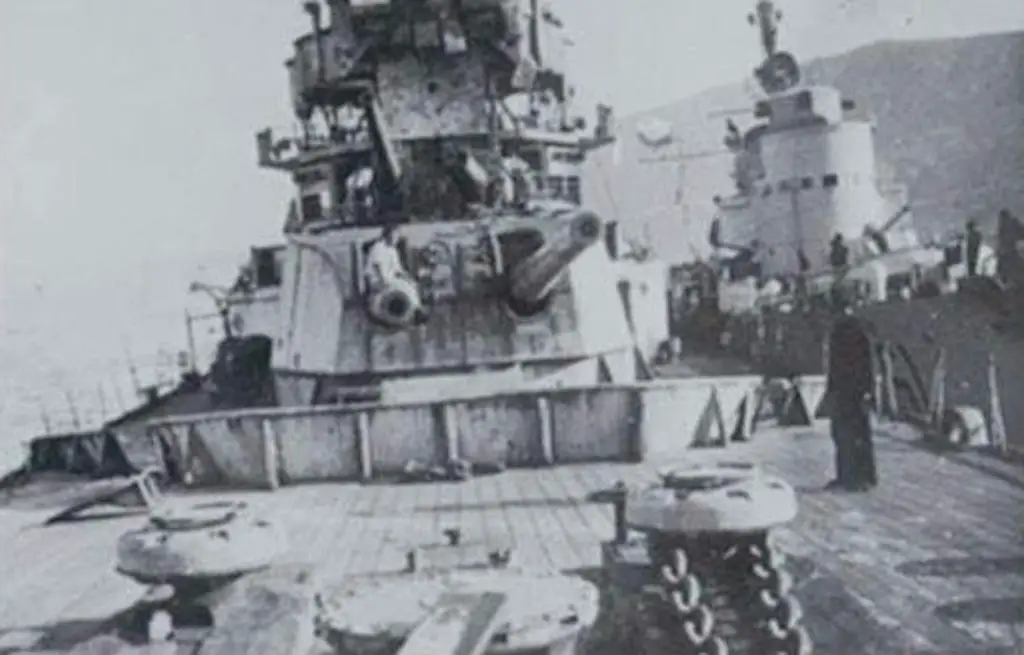
A photo of the crippled HMS York. The Italian torpedo boat Sirio is moored alongside.
June 1941
Soviet Union
22 June – Mussolini is notified by letter that Operation Barbarossa, the invasion of the Soviet Union, is in progress. Mussolini is outraged. He could not understand how a decision that drastic could be made without his approval.
Nevertheless, he insists on helping the Germans and pledges Italian troops to the operation.
26 June – Mussolini reviews 60,000 of the best Italian troops on their way to Ukraine in support of Operation Barbarossa.
For the next couple of months, the Italians proved victorious in the Russian campaign under Giovanni Messe. They were able to drive hundreds of miles into Russia and capture the Dneiper and Bugs River along with the German command.
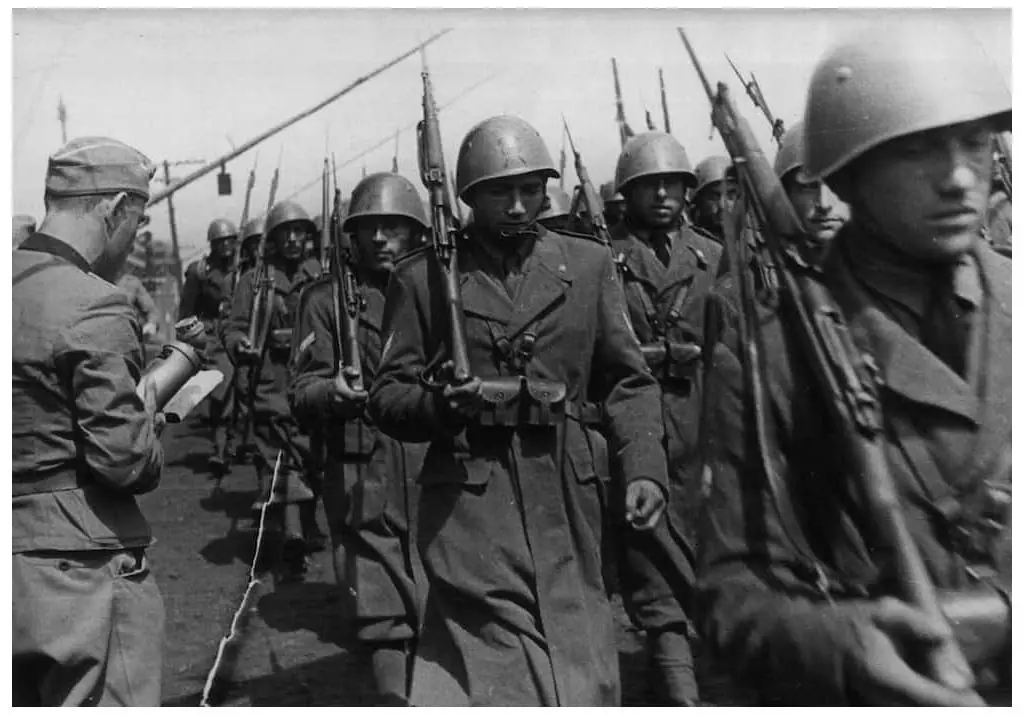
Italian troops in Russia – summer, 1941. Image: Archivio Centrale dello Stato.
July 1941
North Africa
July – The 1st Carabinieri Parachute battalion join the North African front under the disposal of the “Motocorazzato” Army Corps.
Malta
25 July – The Decima Flottiglia MAS is ordered to strike Malta. Italian naval auxiliary ship Diana, carrying 8 small EMB’s, and 2 Torpedo Boats each towing a Maiale leave the port of Augusta, Sicily for the surprise attack. The plan is to attack the convoy ported in Grand Harbour, while one Maiale attacks any submarine ported in Fort Manoel and the other will blast through the defenses of Grand Harbour creating a breach for the EMB’s to sink the convoys. This was all to occur with a simultaneous attack by the Regia Aeronautica to cause a disorder. This plan was destined to fail from the start.
The first thing to go wrong is the Auxiliary ship Diana is spotted on radar 20 miles of the coast of Malta. The second problem is the Regia Aeronautica air attack concluded too early, much before the Maiale’s arrived in a position to strike. This early strike only caused the defenders of Malta to become more alert. Nevertheless, the plan continued.
The Diana put her EMB’s overboard, and they, along with the motorboats, navigated towards the Grand Harbour. Major Teseo Tesei and Chief Diver Pedretti manned the human torpedo (Maiale).
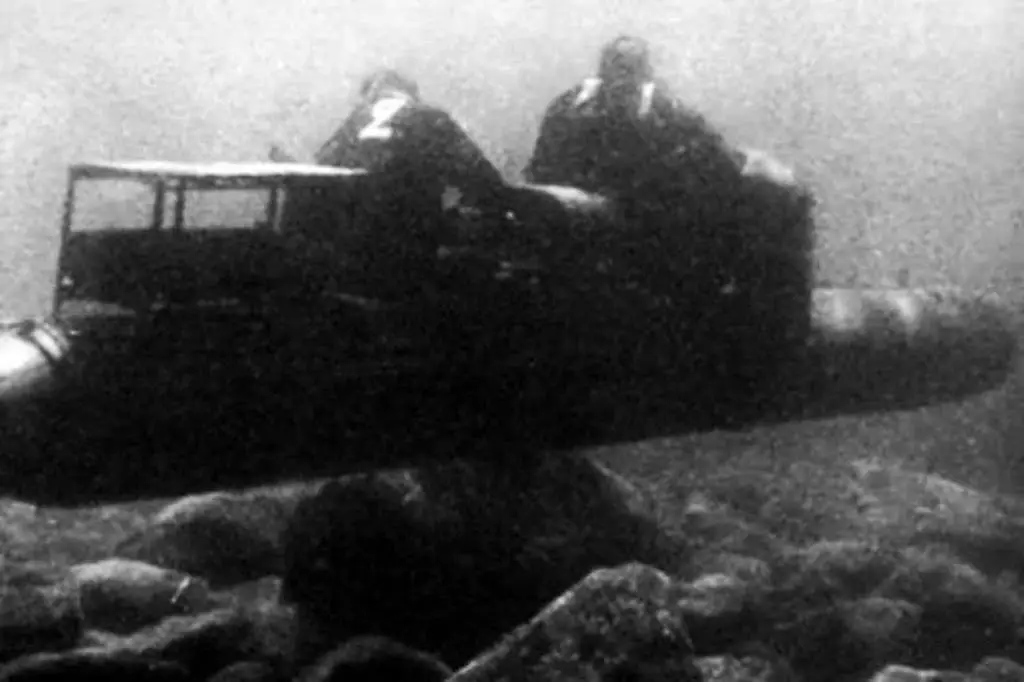
Italian Frogmen of the Decima MAS prepare to strike on a Siluri a Lenta Corsa.
The first explosion occurred at the foot of St. Elmo. This caused the waters to be illuminated by searchlights as the Royal Malta Artillery opened fire. The viaduct to the Grand Harbour is destroyed by another explosion by either Tesei’s warhead or by an EMB which managed to enter the harbor after the first explosion. This inadvertently closed the entrance to the Harbor, but at this point, the Italian attack no longer had the element of surprise. The remaining EMB’s raced to the harbor to do as much damage as possible, but shore-based artillery sank them all. Major Teseo Tesei and Chief Diver Pedretti were never seen again.
30 July – Italian torpedo boat Achille Papa sinks British submarine HMS Cachalot off Malta.
August 1941
Italy
07 August – Bruno Mussolini, Benito’s son, dies while in a training flight on a P108 Bomber in Pisa, Italy. Mussolini never fully recovers from the loss of his son.
Soviet Union
26 August – During Mussolini’s visit to Ukraine to review his troops, General Messe informs Mussolini that his soldiers lack proper arms and few vehicles with even less fuel. He also notes that the Germans were reluctant to share supplies, yet were quick to criticize Italian failures due to supply problems. His troops began suffering from the Russian cold weather and needed warmer uniforms. Mussolini shrugs him off and tells him to make do with what he has.
September 1941
Libya
14-16 September – A poorly executed raid by Rommel, forces his 21st Panzer Division to run out of fuel. The RAF commence bombing the exposed German units. Rommel again places his German units out of fire and orders the Italians to guard the flanks.
Logistics become a nightmare for the Italians with two Germans Divisions consisting of 7,000 vehicles and 8,500 vehicles for Seven Italian Divisions.
GIBRALTAR
20 September – The Decima Flottiglia MAS is able to complete its second attempt at attacking ships ported in Gibraltar. Human Torpedoes successfully sink 2 tankers Fiona Shell and Denby Dale and the British H.M.S. Durban. The pilots and divers successfully escape by swimming to Spanish shores.
October 1941
Soviet Union
October – Italian troops advance rapidly in the Soviet Union, sometimes up to 250 miles a week. At one point, the Italian military was strung out in a 500-mile line.
Mediterranean
14 October – British bombers sink Italian torpedo boat Pleiadi off Tripoli.
20 October – Aldebaran and Altair sink after hitting a minefield in the Aegean.
November 1941
Libya
November – Under Erwin Rommel, the Afrika Corp now consisted of the 15th and 21st Panzer Divisions and 2 Italian Corps numbering 6 Divisions. They also had 400 tanks, although 150 were obsolete Italian vehicles.
09 November – British Force K sink Italian destroyers Fulmine and Libeccio off Tripoli.
18 November – Rommel dismisses Italian warnings of a possible British attack and destroys Italian reconnaissance photo’s revealing a massive increase in British vehicles and men. Rommel states the Italian warnings as “excessive Latin nervousness”. Luckily for Rommel, Ettore Bastico convinces Rommel not to deploy his armored units around Tobruk. Gastone Gambara and Fedele de Giorgis place the Ariete, Trieste and Savona Divisions on alert.
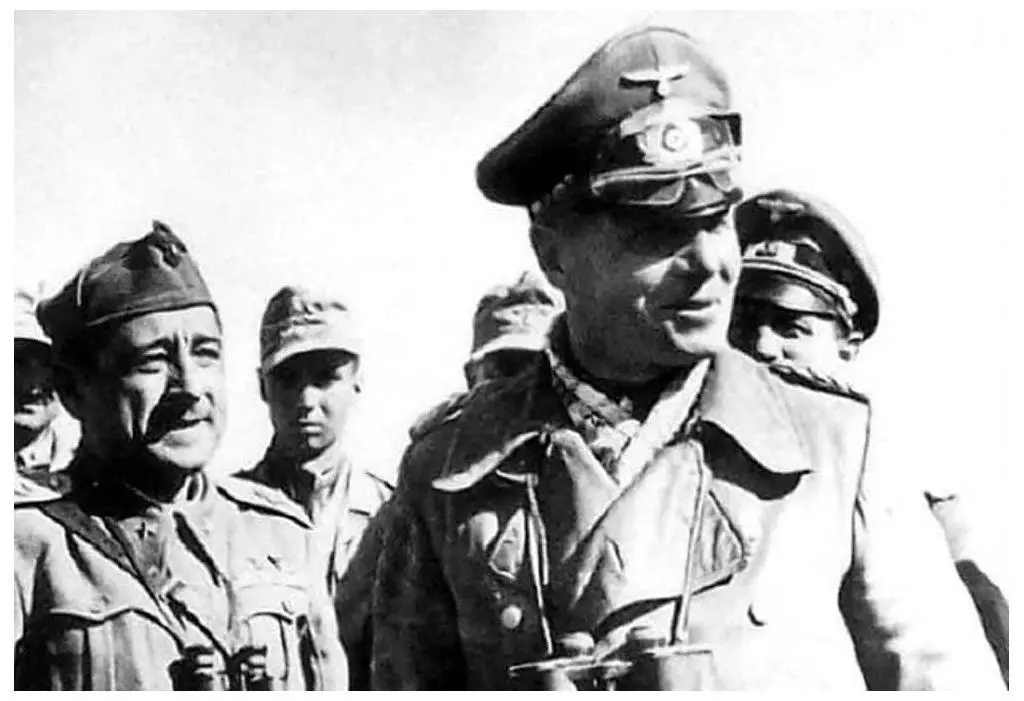
Rommel and Marshal Ettore Bastico in 1941.
Bir el Gobi
19 November – British attack Axis forces at Bir El Gobi. Ariete’s 146 M13/40’s take the brunt of the attack and stop the British advance. The Ariete deploy in three battalion-size formations with twenty-four 75/27’s, thirty 47/32’s, twelve 105/28’s and seven 102/35’s. The Ariete with 73 guns and 137 tanks, engaged the 28 pdrs. and 158 Crusaders of the XXII Armoured Brigade of the British. The XXII lose 55 tanks (see note below) at Bir El Gobi and spend the next two days in the Allied rear regrouping. The 21st Panzer also managed to destroy 23 of the IV Armoured Brigades tanks. Over the next few days, the Ariete attack the XXII and IV Armoured Brigade and by November 23, the Ariete, Trieste, and Savona account for numerous British tanks and vehicles destroyed. The Bologna, Trento and Pavia Divisions contained Tobruk. Because of the independent actions of the Italian and German subordinate, Rommel was saved from disaster.
* Playfair vol.II p.40 states the 22nd Armoured Brigade lost 25 out of 136 tanks at El Gubi on 19th November. They did not spend the next two days in the allied rear regrouping. The next day, on the 20th November, 22nd Armd Bde joined 4th Armoured Bde in a battle at Gabr Saleh with 15th Panzer Division. On 21st November they pursued DAK to Sidi Rezegh, and on the 22nd November, the 22nd Armoured Brigade was virtually destroyed in battle with DAK at Sidi Rezegh.
~ Additional commentary courtesy Paul (goldwood(@)paradise.net.nz)
Corelli Barnett states in his book “The Desert War” that 52 British tanks were lost in this event. Major-General Gerald Lloyd Verney, the divisional historian for the 7th Armoured Division, gives the loss as 45 tanks, while Robin Neillands in his book “The Desert Rats” says 40 Crusader tanks were lost in the action. Additional commentary by David Aldea (2manypeople(@)gmail.com)
El Duda
26-27 November – The 9th “Trieste” Regiment of Bersaglieri encounter the Freyberg’s troops in El Duda. Official New Zealand history of war reports:
The Bersaglieri Regt. fought with much greater determination than is usually found among the Italian troops and the numbers of their dead and the positions in which they lay showed that they had kept their guns in action to the last.
28 November to 04 December – Italians troops are engaged in heavy fighting with British Commonwealth forces around Tobruk and Sidi Rezegh.

battle map.
December 1941
01 December – British Force K sink Italian destroyer Alvise Da Mosto off Tripoli.
Bir el Gobi
04-07 December – Another successful engagement by Italian forces in Bir El Gobi, when the battalion of Giovanni Fascisti mauls the XI Indian Brigade, destroying 100 tanks. Norrie’s troops, who had an overwhelming advantage in every area, failed to concentrate their actions against the Italians causing one arm of the Italian battalion, the “Giovanni Fascisti” to block the actions of his corps and inflicted heavy casualties on one of his brigade The Giovanni Fascisti engaged the British army corps for 4 days and severely damaging the IV Armoured Brigade. The IV Armoured Brigade had to retreat 20 miles in order to reorganize. This forced Ritchie to abandon his intent to attack Rommel’s southern flank and trap his forces in Gabr Saleh.
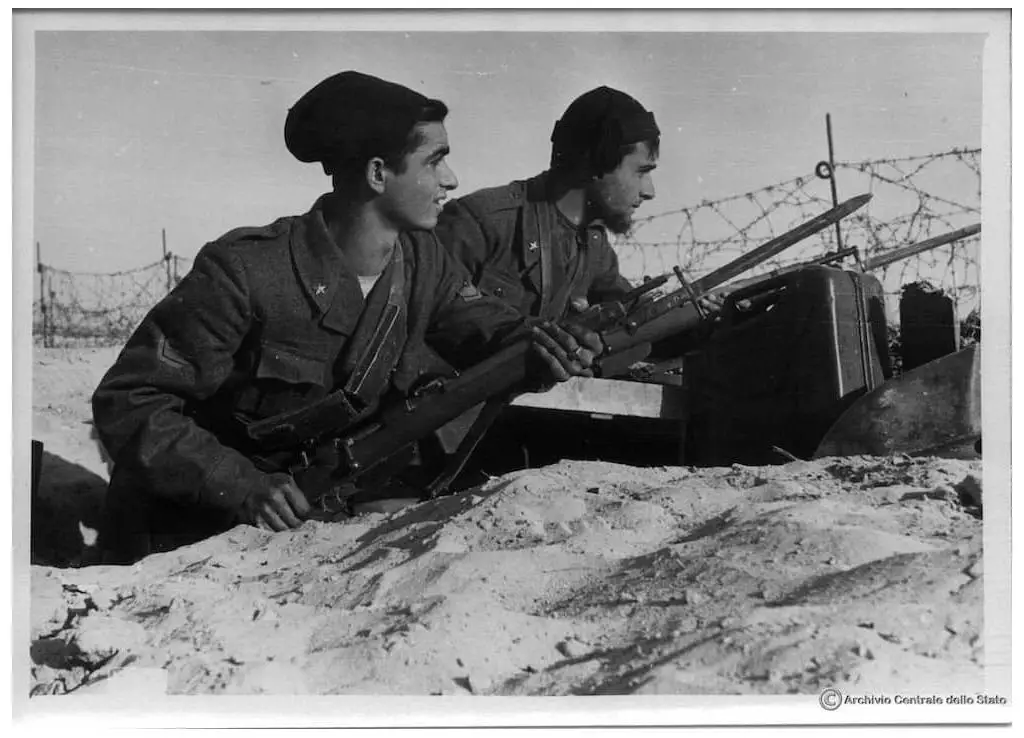
Giovani Fascisti manning a position in North Africa. The photo appears to be taken in the winter.
Note: About the “Giovani Fascisti” – The 1st and 2nd Battalions of this Regiment stopped the 11th Indian Brigade, the 4th Armored Brigade, and the 1st S.A division from the period of December 2nd to the 7th, 1941, protecting the back of DAK saving the Italo-German army. Michael Carver, an author, writes of the Italian parachute division at Bir El Gobi:
…The “Folgore” parachute division “gave a very good account of itself” and that it was “the best of the Italian divisions” should not be taken as simply a random observation.
05 December – Rommel orders a general retreat and “forgets” to notify the Trieste and Ariete Division, forcing them to fight through the British Commonwealth IV Armoured Brigade and the 7th Support Group to rejoin the retreating German forces. Rommel’s hasty retreat cost the Italian Ariete and Trieste Divisions greatly, however, their determination to fight through the surrounding British gave the Ariete and not DAK, the first major tank battle of North Africa and accounted for another 100 British Commonwealth armored vehicle losses at Alam Hamza.
Italy
08 December – A group of the Sezione Prelevamento (Withdrawal Section) of Italian Army intelligence (SIM Servizio Informazioni Militari) lead by Maj. (Carabinieri) Talamo break into the U.S. embassy in Rome and steal a codebook known as the “Black Code”. They photograph the codes and put it back in the safe. These photos were used to decipher top-secret messages sent from Cairo to Washington D.C. about British strength and weaknesses in Africa. This discovery was what gave Rommel the early successes in the desert war.
The Italians always managed the Black Code. They gave the Germans only the deciphered messages in regards to actions in North Africa.
Note: Maj. Talamo died March 22nd, 1944 shot by Germans at Fosse Ardeatine
11 December – Mussolini declares war on the United States of America. His speech was short, he knew the Italian people were uneasy about a war with America. Most Italians had relatives there and hoped to one day come to America to live the “American Dream”.
British submarine HMS Truant sinks Italian torpedo boat Alcione off Crete.
Mediterranean
December 13 – British destroyers sink Italian cruisers Alberico Da Barbiano and Alberti Di Giussano off Tunisia.
Africa
Mid-December – British Commonwealth forces commence the big offensive action known as “Crusader”. The Italian Carabinieri Parachute battalion joins the battle against the Commonwealth forces with the other Italo-German forces and charged to protect the “Ariete” Division, which was withdrawing after a successful attack of British armored forces. Although the amount of Italian 75 mm guns in North Africa remained the same as it was in 1940, the Italians had doubled the amount of 100/17 guns to 24 and added twelve 88/55′s, giving each Division 60 guns for a 10:1 ratio of artillery to battalion compared to the 6:1 it had during Graziani’s first attacks from Libya. Coupled with Rommel’s German forces, the Axis war machine had doubled the firepower of what Graziani had available in 1940.
Mediterranean
December 17 – First battle of Sirte ends indecisively.
December 18 – Force K, the British Flotilla assigned to protect Malta and its shipping, hits an Italian moored minefield 20 miles east of Tripoli. The cruiser HMS Neptune and destroyer HMS Kandahar are sunk, the cruiser HMS Aurora is badly damaged and the cruiser HMS Penelope is slightly damaged. The site of the stricken ships limping back to the Grand Harbour brought a sense of fear into the Maltese people, who depend on the protected convoys to survive.
Africa
December 18-20 – The Carabinieri Parachute battalion repeatedly engage the British Commonwealth forces at the Eluet el Asel fork in the Cerenaic Djebel. After holding the violent attacks of the British forces, the Carabinieri Parachute battalion get the order to withdraw and shoot their way out of encirclement with a brave attack near Lamluda fork along the Balbia road. They finally reached the Italian lines after suffering 35 dead and 251 missing. For their bravery and sacrifice, the Carabinieri Parachute battalion’s Flag of Arm was decorated with the silver medal to the military valor.
Alexandria, Egypt
December 19 – The H.M.S. Valiant and H.M.S.Queen Elizabeth, while moored in the port of Alexandria, are critically damaged by explosions under their keels planted by Human Torpedo’s operated by Italian frogmen of the Decima Flottiglia MAS. The damage was so great that these two ships were deemed unseaworthy. Along with the Battleships, the tanker Sagona and the British Destroyer Jervis were also severely damaged. Two Italian frogmen are captured, Lt. Luigi Durand de la Penne and Lt Bianchi. They refused to divulge any information until moments before the explosion (because they were being interrogated right above the area of the keel where the explosion was to occur). This attack, which neutralized the ability of the British to oppose the Italian Regia Marina with its battleships, allowed deeply needed convoys to supply Axis forces in Africa.
Read our article: Decima MAS Attack on Alexandria.

Italian map of the Decima MAS raid on Alexandria Harbor.
LIBYA
December 28 – CAM (Corpo d’Armata di Manovra – Mobile Army Corps) joins the DAK in attacking the XXII Armoured Brigade. “Trieste” Division captures key documents in a British Command Tank.